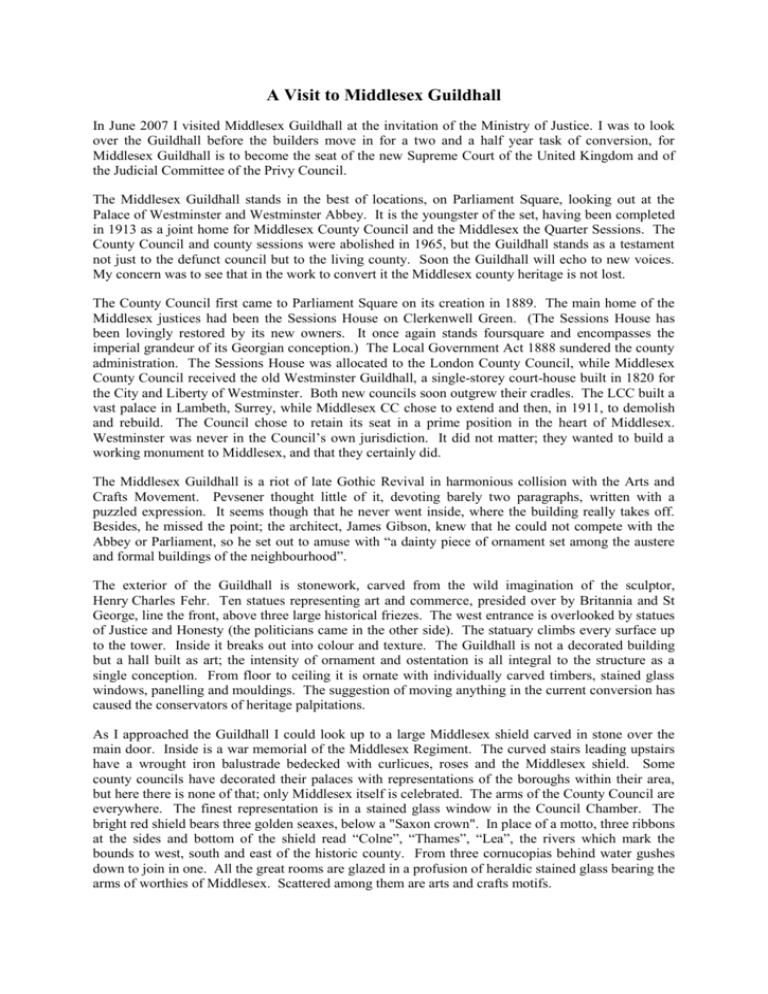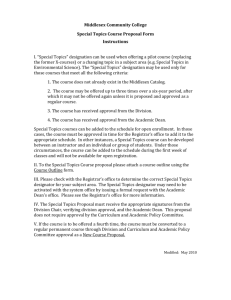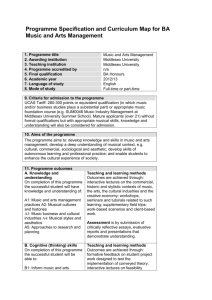A visit to Middlesex Guildhall
advertisement

A Visit to Middlesex Guildhall In June 2007 I visited Middlesex Guildhall at the invitation of the Ministry of Justice. I was to look over the Guildhall before the builders move in for a two and a half year task of conversion, for Middlesex Guildhall is to become the seat of the new Supreme Court of the United Kingdom and of the Judicial Committee of the Privy Council. The Middlesex Guildhall stands in the best of locations, on Parliament Square, looking out at the Palace of Westminster and Westminster Abbey. It is the youngster of the set, having been completed in 1913 as a joint home for Middlesex County Council and the Middlesex the Quarter Sessions. The County Council and county sessions were abolished in 1965, but the Guildhall stands as a testament not just to the defunct council but to the living county. Soon the Guildhall will echo to new voices. My concern was to see that in the work to convert it the Middlesex county heritage is not lost. The County Council first came to Parliament Square on its creation in 1889. The main home of the Middlesex justices had been the Sessions House on Clerkenwell Green. (The Sessions House has been lovingly restored by its new owners. It once again stands foursquare and encompasses the imperial grandeur of its Georgian conception.) The Local Government Act 1888 sundered the county administration. The Sessions House was allocated to the London County Council, while Middlesex County Council received the old Westminster Guildhall, a single-storey court-house built in 1820 for the City and Liberty of Westminster. Both new councils soon outgrew their cradles. The LCC built a vast palace in Lambeth, Surrey, while Middlesex CC chose to extend and then, in 1911, to demolish and rebuild. The Council chose to retain its seat in a prime position in the heart of Middlesex. Westminster was never in the Council’s own jurisdiction. It did not matter; they wanted to build a working monument to Middlesex, and that they certainly did. The Middlesex Guildhall is a riot of late Gothic Revival in harmonious collision with the Arts and Crafts Movement. Pevsener thought little of it, devoting barely two paragraphs, written with a puzzled expression. It seems though that he never went inside, where the building really takes off. Besides, he missed the point; the architect, James Gibson, knew that he could not compete with the Abbey or Parliament, so he set out to amuse with “a dainty piece of ornament set among the austere and formal buildings of the neighbourhood”. The exterior of the Guildhall is stonework, carved from the wild imagination of the sculptor, Henry Charles Fehr. Ten statues representing art and commerce, presided over by Britannia and St George, line the front, above three large historical friezes. The west entrance is overlooked by statues of Justice and Honesty (the politicians came in the other side). The statuary climbs every surface up to the tower. Inside it breaks out into colour and texture. The Guildhall is not a decorated building but a hall built as art; the intensity of ornament and ostentation is all integral to the structure as a single conception. From floor to ceiling it is ornate with individually carved timbers, stained glass windows, panelling and mouldings. The suggestion of moving anything in the current conversion has caused the conservators of heritage palpitations. As I approached the Guildhall I could look up to a large Middlesex shield carved in stone over the main door. Inside is a war memorial of the Middlesex Regiment. The curved stairs leading upstairs have a wrought iron balustrade bedecked with curlicues, roses and the Middlesex shield. Some county councils have decorated their palaces with representations of the boroughs within their area, but here there is none of that; only Middlesex itself is celebrated. The arms of the County Council are everywhere. The finest representation is in a stained glass window in the Council Chamber. The bright red shield bears three golden seaxes, below a "Saxon crown". In place of a motto, three ribbons at the sides and bottom of the shield read “Colne”, “Thames”, “Lea”, the rivers which mark the bounds to west, south and east of the historic county. From three cornucopias behind water gushes down to join in one. All the great rooms are glazed in a profusion of heraldic stained glass bearing the arms of worthies of Middlesex. Scattered among them are arts and crafts motifs. The Council Chamber itself is breathtaking. It is made to resemble a mediæval great hall. Its broad hammer-beam roof, with dark timbers, spans the room, with huge bosses carved into roses and other symbols. At the stems of the beams life-size timber angels look out across the space. On either side, the gothic-arch windows reach up toward the ceiling, broad glass lighting the chamber. The windows bear the arms of the Lord-Lieutenants of Middlesex from the early eighteenth century, the Dukes of Newcastle, Northumberland, Portland, Wellington and Bedford amongst others. The walls are oakpanelled. The gable walls appear to be of Caen stone, though I am told it is painted on. If restored in keeping with the artistic conception, as is promised, this will be worthy to become as planned the principal courtroom for the Supreme Court. The two original court rooms are of similar Gothic build, each given an individual character. Court 1 has fan vaulting reaching up to a rose ceiling with the royal arms (all moulded in plaster despite appearances). Court 2 is arcaded. The windows in the courts show the arms of the Sheriffs of Middlesex and Chairmen of Quarter Sessions. Nineteen in all are represented in the two courts and up the grand staircase. Serving the council too were a set of ornate formal rooms and corridors, and of course more ordinary, functional rooms. The Justices of the Supreme Court will have ornate offices (and no getting away from the building's history; even their fireplaces are Middlesex-branded). The support staff will be content with the servants' quarters. In 1965, Middlesex County Council was abolished. It had lived for almost 80 years, created under the ministry of Lord Salisbury (whose father's arms still look down upon the Chamber). Middlesex itself, some thirteen centuries old, of course remained, though excised from the maps. The Guildhall was abandoned to the Quarter Sessions alone, until the Crown Court replaced them after 1971. The Crown Court sat perhaps uncomfortably in the Council Chamber, the judge looking down on the concentric pews from the lofty height of the Chairman's throne. Other rooms hosted the court in more rectilinear circumstances but mostly under the same dark, carved timbers and heraldic stained glass worthies. The court closed in the spring of 2007. The new Supreme Court should open in the autumn of 2009. Fehr's figures of justice have illustrated the local magistrates, then a Crown Court, and will finally be promoted to supervising the Supreme Court of the whole Kingdom. The workmen have moved on site. Scaffolding blankets the outside. The building's art collection is gathered away upstairs. The Middlesex Regiment's war memorial is moving across the lobby. The cluttered light-wells will be cleared of modern encumbrances and restored as once they were; the windows will shine the brighter for it. Three rooms will be knocked into one; not in the usual way but vertically; the floor Court 1 which I walked across will be thin air as the room becomes the upper gallery of a library. The Court's stunning ceiling will now serve as the apex of the library. Its oak panelling and heraldically embellished windows will remain but high above the floor. That is radical, but it still fits the artistic conception of the Guildhall as a whole. Elsewhere the work is restoration. Every surface is being cleaned, removing the grime of a century. A 1980's detention centre is being cleared from one of the light-wells, and plant from another. The timber will all be stripped, cleaned and restored. Stained glass experts are painstakingly cleaning and repairing the windows and lights. The Council Chamber will undergo a change which has caused outrage amongst the conservators of heritage. The hammer-beam roof, the angels and the stained glass windows will remain. Below though, all is changing. My eyes were charmed by gorgeous carved wood furniture filling the chamber, from the Chairman's throne and throughout the oaken seats for the councillors, all carved by Fehr with loving care in the Gothic idiom filling the space as an artistic whole. It will all be ripped out and carted off to a court in Snaresbrook in Essex (where the judge might wonder why his bench bears the arms of neighbouring Middlesex). This has been the big conservation fight. “Save Britain's Heritage” even launched a doomed judicial review. The Orwellian-sounding Ministry of Justice pleads that it wishes to convert the building in a way that is sensitive to its history, but the new tenants, the Supreme Court and the Judicial Committee, are rather different from those for whom the Middlesex Guildhall as it was built. The Law Lords do not look down upon their courts but in collegiate informality sit all on a level. The lofty pulpit where the Chairman and the clerks sat has no place. There are no longer ranks of earnest councillors to fill the pews. Thus the great Council Chamber is to be stripped bare. As a compromise some of the individually carved bench-ends (with carved beasts whose identities have been obscured by the rubbing of decades of anxious hands) will stay. The room will echo in emptiness still. It will be sad to lose such an element of the building's artistic conception. However form follows function. The artistic beauty of the council chamber and its grand furnishings are part of the glory, but it is all redundant. Forcing the Supreme Court into an unsuitable room, they would feel like mere lodgers waiting for the ghost of the County Council to return to claim its own. Weep but briefly, for the master left his home over forty years ago, and will not return. He is not forgotten though; looking down over the hearings of the Kingdom's highest court will be the old virtues, in pre-Raphaelite allegorical maidens, and still the arms of the County of Middlesex and the Lord-Lieutenants of the shire. The abused Council Chamber has a sister though. James Gibson's earlier Gothic triumph was the West Riding's County Hall in Wakefield, now occupied by Wakefield City Council. Its Council Chamber was copied in the new Guildhall, after a visit in 1913. The original remains in use, whatever is lost in Westminster. The Guildhall will always be in Middlesex but it will cease to belong to Middlesex except in spirit. The Middlesex arms above the main door will be replaced by the Royal Arms. The law lords and the Ministry are anxious that the new Court have its own distinct identity, serving the whole Kingdom. That could harm the distinctive Middlesex identity of the building, threatening even its name. The loss of the arms above the door is sad, though inevitable. At least, with heritage in mind, they are just going to cover the shield up rather than chisel it off. For all the changes of form and function, the Middlesex connection will not be all lost. Middlesex is crafted into every aspect of the fabric of the Guildhall. It will remain a monument to Middlesex, even if the barbarians at the gate take its very name. I doubt that the name, "Supreme Court of the United Kingdom and Judicial Committee of the Privy Council Hall" would catch on. Those in charge should recognise the value of the name "Middlesex Guildhall" and what it means to those who love Middlesex. There is no need for change; Westminster Abbey has kept its common name, and there has not been an abbot nor any monkish folk there for almost 500 of its 960 years. Middlesex, older still, remains. I was encouraged by one continued Middlesex tradition. Middlesex Day, 16th May, remembers the day the county regiment stood fast, died hard and turned the tide at Albuhera in 1811. The day is still marked and will still be marked by the raising of the Middlesex flag from the flagstaff atop the Guildhall's tower. At the end of my tour I was led down from the dock into the cells (for the only time in my life, I hope). A condition of the planning permission requires that there be an exhibition on the history of the building and by extension of Middlesex. Down there in the bowels the Historic Counties Trust has a job to do. The Historic Counties Trust is a guardian of county heritage and we have been asked to help provide material for the exhibition. The Guildhall's stained glass is a library in itself. It will remain after the conversion work. I have pictures of it all and I am compiling an inventory. I have also been writing histories of the Guildhall's predecessors, writing biographies, crawling over old maps, terrorizing librarians across the county. It does need ideas and local input too though. I hope that the Historic Counties Trust can provide visitors to that special building with an understanding of Middlesex and its fine heritage. Rupert Barnes 'This article has previously appeared in "The Counties"'









